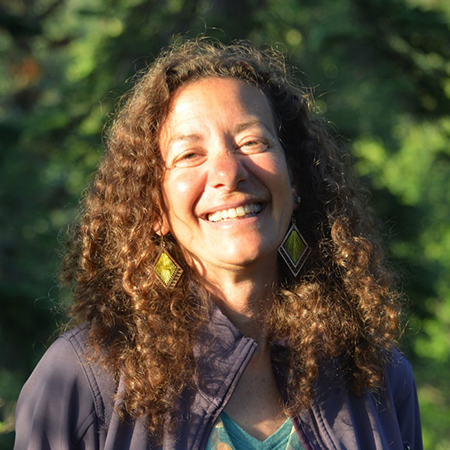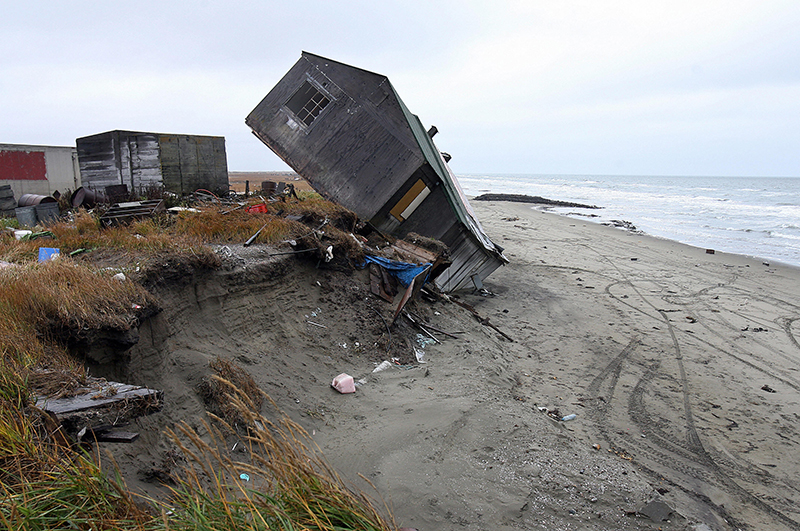After a natural disaster such as a hurricane or earthquake, the U.S. government steps in with money to rebuild. But that’s not the case for the slow-motion hazards of sea-level rise, erosion, and melting permafrost. A number of Alaska Native villages have been impacted so severely by these climate-induced threats, they have decided to relocate. Yet there is no agency designated to pay for and help implement an entire community’s move.
Robin Bronen, a senior research scientist with The Institute of Arctic Biology at the University of Alaska, says that’s a huge problem.

In an interview with Yale Environment 360, she explains that no government process exists to facilitate such relocations or to respond to people’s health and well-being in the interim. So despite their resolve to move, none of these villages have been able to do so. And in a bureaucratic Catch-22, these communities no longer receive the infrastructure repair funds they were once entitled to.
Bronen, an attorney who is also executive director of the Alaska Institute for Justice, is advocating for what she calls an “adaptive government framework” to help communities identify when they need to start considering relocation. For as sea levels continue to rise, the relocation problems Alaska Native villages are coming up against are a harbinger of a much larger problem. “If we don’t figure out how to create this relocation institutional framework,” she says, “we’re talking about humanitarian crises for millions of people living in the United States.”
Yale Environment 360: Federal disaster relief laws help communities rebuild and defend against future disasters, but don’t help them permanently relocate. You’ve proposed an “adaptive government framework” to address relocations. What do you mean by that phrase?
Robin Bronen: The Stafford Act is the primary federal legislation that governs disaster relief and response in the United States, and as you articulated, it’s primarily focused on protection in place. When I talk about adaptive governments in this context, I always start with protection in place as the priority, and people need to be given the resources and availability of technology to make that possible. The challenge is that sea level rise and erosion [currently] are not qualifying environmental incidents that can then release funding and there’s going to come a point when land is going to start to permanently disappear.
With an adaptive government framework, what would happen is you would be able to have a continuum of responses, from protection in place to community relocation. Indicators to identify when a relocation process needs to be implemented would be identified by local communities as well as local, state, and possibly national government representatives. By doing that, the funding that normally goes to protecting people in place could then be used in a relocation effort.
e360: Under this scenario, who would have the final say regarding whether relocation is needed or not?
“When I talk about relocation, I always talk about this as a human rights issue.”
Bronen: When I talk about relocation, I always talk about this as a human rights issue. Any institutional or government’s framework needs to be based in human rights doctrine. The right to self-determination is one of the most fundamental rights in this context, which means that community members would be the people who would be deciding whether or not relocation would be implemented.
e360: In some Native Alaska communities, the loss of ice has lead to severe erosion. Paint a picture of what happens in these villages when erosion begins to take a toll.
Bronen: Erosion causes a host of problems. Lives are in danger as erosion continues to eat away at the coastline. Without Arctic sea ice protecting the coast, the storms that come in can completely inundate communities. And because of that inundation, there is then saline intrusion on potable water sources, which then affects the public health of the communities. In 2014, Kivalina [a native village on Alaska’s west coast] had no drinking water for several months because of the problems with infiltration of their water system because of the severe erosion that was occurring.
e360: And it’s not like they can go to the local 7-11 and pick up a bottle of water.
Bronen: No, we’re talking very small communities of a few hundred people who have maybe one or at most two stores to buy food and beverages. Those items are usually extremely expensive because they have to be flown in.
e360: I’ve read that there’s even a mental health aspect to this issue.
Bronen: When the storms come in in the fall, they’re terrifying. You have to understand the geography of Alaska. There are very few roads connecting the 229 indigenous villages that are within the state. The coastal communities along the western coast of Alaska are communities whose only access to safety is primarily by small ten-seater planes. When storms come in and people’s lives are threatened, there is no evacuation route to get them to higher ground. Shishmaref and Kivalina are barrier islands, so they are surrounded by water.

e360: Today, if a community decides that storm surge or melting permafrost or erosion has become so severe that relocation is necessary, what kind of assistance is available? Who do you call?
Bronen: That’s actually a hard question to answer. My initial response is there is no one to contact, but that’s not exactly true. The challenge is that there’s no one point of contact in the federal or state government system. So if a community is thinking that they need to relocate, if they’ve had any work done by the U.S. Army Corps of Engineers, they may contact a person in the US Army Corps of Engineers. If they’ve had any contact with state government community planners, they may contact that office”¦ But there is no identified federal or state government agency that is tasked with this issue, which is one of the huge problems.
e360: I think we can also see that with the village Newtok, which made the decision years ago to move but it’s yet to be able to do that. It appears that funding is the big obstacle.
Bronen: Actually, funding is, in my mind, a red herring. It gets us away from the real issue, which is that we don’t have a government framework. Without a government framework, even if there was all the money in the world available for Newtok’s relocation, we still don’t have that government framework to orchestrate the work of, at a minimum, two dozen federal and state government agencies to build the infrastructure and also make sure that people’s health and well-being is taken care of in the relocation process.
One of the consequences of not having that institutional relocation framework is that when communities make the decision to relocate, that community will no longer be able to access funding for capital projects that every community in Alaska is eligible for. That money then becomes available to other communities. For instance, in Newtok, they have seriously deteriorating infrastructure that is a danger to the people living within that community. They’ve had issues with accessing potable water, they’ve had issues with accessing electricity because of challenges in regard to the fuel tanks that are holding the diesel fuel that runs their generator. So what winds up happening is communities are left with deteriorating infrastructure, and there’s no mechanism to take the money that the community would normally have access for fixing that infrastructure and have it be allocated instead to a relocation site.
e360: That is quite a Catch-22.
“There are going to be millions of people living along the coast of the U.S. who are going to be in a similar situation.”
Bronen: Yes, which is why passionate doesn’t quite describe the intensity with which I advocate for creating this relocation institutional framework. Because my greatest concern is that if we don’t figure this out soon, there are going to be millions of people living along the coast of the United States who are going to be in a similar situation.
I was just in southeastern Florida, where the issue of relocation is becoming more real for them, because what they’re calling nuisance flooding is becoming more consistent. There is a recognition that there is no technology to protect people in place because of the porous geography there. And the reality is that we don’t know how fast or how much sea level is going to rise.
If we don’t figure out how to create this relocation institutional framework, we’re talking about humanitarian crises for millions of people living in the United States.
e360: A recent study published in Nature Climate Change put that number on the continental U.S. at anywhere between four and 13 million by the year 2100.
Bronen: I think the challenge is that when people start projecting about time frames, they’re based on models that are probably not completely accurate. If you don’t have that very local and ecosystem-specific observation, the regional or global models for sea level rise are not going to be accurate for the particular locations where people live along the coast.
e360: How much longer do the hardest-hit communities [in Alaska] have before they become uninhabitable?
Bronen: That’s really hard to say again, because we don’t have local data to give a really clear indication of time frames. Newtok was supposed to be relocated by 2012. They are in a dire situation, as are Shishmaref and Kivalina. It honestly depends on the fall storm season. Arctic sea ice is reaching record lows every month this year. Without that Arctic sea ice in the fall, communities are vulnerable to the storms that come in. You have one storm with a wind direction that pushes that storm surge over the barrier islands of Shishmaref and Kivalina, and it’s unclear how people would be able to remain there.
e360: What’s been the receptivity to the adaptive government framework you’re advocating?
Bronen: President Obama’s task force on climate preparedness and resilience has recognized that there is this institutional gap and that the U.S. needs to take a lead on it. I think that there are people working within the federal government who understand that this is a huge gap in regards to responding to climate change and that the complexity of it is overwhelming.
e360: There is a certain irony here considering the imposed end of Alaska native people’s nomadic lifestyle.
“People need to document the environmental changes happening in their communities, so they understand the risk.”
Bronen: Absolutely. And in my mind, that issue is about accountability and who’s responsible for figuring out how to make people safe, because it was not their choice to become sedentary and live in these places that were chosen because they were easily accessible for barges that were dropping off construction materials to build schools.
e360: Your organization, the Alaska Institute for Justice, has received funding from NOAA and NSF to develop a community-based process to access and monitor climate risks. Tell me more about the goal of the project.
Bronen: We are working with fourteen tribes right now. The idea is that people need to document the environmental changes that are happening in their communities, so that they themselves understand the risk, and also can document the impact on the infrastructure and on their health and well-being.
The idea is that communities will document these changes, and do it alongside state and federal government agencies that can then provide the resources — the technical assistance, the funding resources — to adapt to climate change as climate change continues to happen. One of my new refrains now is, “Adaptation is Forever.”
e360: Earlier this year, the Department of Housing and Urban Development awarded a tribe close to $50 million to relocate off a Louisiana island that’s disappearing because of a number of factors, including sea level rise. What are your thoughts about that?
Bronen: It’s awesome that the community has received the funding that they need to relocate, but there are two issues when we’re talking about this relocation institutional framework. One of the issues is at what point should a relocation occur, prior to a humanitarian crisis occurring, which is the focus of the work that we are currently doing here with the fourteen tribes. Then the other issue is once relocation is determined to be the best long-term adaptation strategy, who within state and federal government agencies is responsible for implementing that relocation process.
I’ll also say that in the context of the tribe in Louisiana, it’s actually somewhat similar to the context of the Alaska Native communities in regard to accountability, because that tribe was left out of the levy system that was built to protect southern Louisiana.
e360: You’ve worked internationally on this issue, including participating in a U.N. working group on climate displacement.
ALSO FROM YALE e360Rethinking Urban Landscapes To Adapt to Rising Sea Levels

Are other nations ahead of us on dealing with this issue, or is everyone playing catch-up?
Bronen: I would say the country that has done an equal amount of work in trying to solve this is Fiji. There are, I believe, over 1,100 indigenous communities in Fiji, and 47 of them need to relocate. The Fijian national government is trying to figure out what a relocation institutional governance framework would look like and are actively working with the communities in Fiji to problem solve that.
e360: You’ve written that extreme weather events, even if they cause mass displacement, may not be an appropriate indicator to evaluate whether people should be relocated, why not?
Bronen: Extreme weather events may not be the indicator to determine whether or not people need to be permanently relocated unless a lot of research has been done prior to that extreme weather event to determine that that place can not be protected by the traditional technology that we’ve used to protect, for instance, coastal communities — I’m thinking of sea walls and levees. If you do not have that prior information to make that determination, that it’s not safe for people to continue to live where they have been living, then you’re talking about possible, forcible eviction, where there is no legitimate basis for preventing people going back to the places where they’ve lived.
A relocation process takes a significant amount of time, possibly five to ten years, if not longer, in order to make sure that people’s human rights are protected and that their lives and livelihoods are going to be maintained or improved.